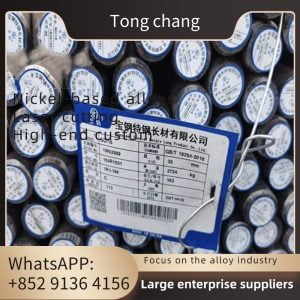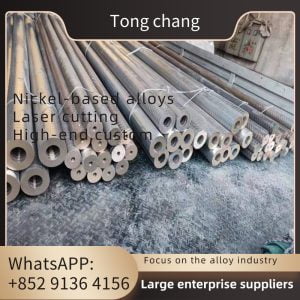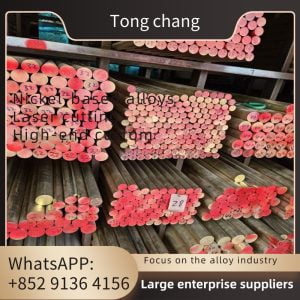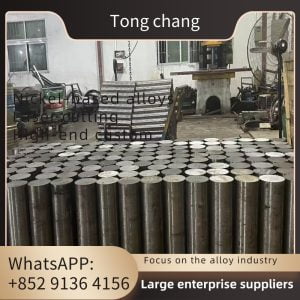| Product Name: | Forged Tubesheet | Standard: | EN10222-4 |
|---|---|---|---|
| Material: | P280GH / 1.0426 | Size: | Can Custom, As Buyer’s Drawing Requirements |
| Shape: | Cylinder | NDT: | 100% PT, UT, PMI |
| Application: | Tubular Heat Exchanger, Boiler, Pressure Vessel, Steam Turbine, Large Central Air Conditioning, Etc. | ||
| High Light: | P280GH Carbon Steel Tubesheet, Forged Heat Exchanger Tubesheet | ||
Forged EN10222-4 P280GH / 1.0426 Carbon Steel Tubesheet for Heat Exchanger / Pressure Vessel
EN 1.0426 steel is a high-temperature carbon (non-alloy) steel formulated for primary forming into wrought products. Cited properties are appropriate for the normalized condition. 1.0426 is the EN numeric designation for this material. P280GH is the EN chemical designation.
It has a moderately high ductility among the wrought carbon or non-alloy steels in the database.
EN 10222-1: 1998 Steel forgings for pressure purposes. General requirements for open die forgings
EN 10222-2: 2000 Steel forgings for pressure purposes. Ferritic and martensitic steels with specified elevated temperature properties
EN 10222-3: 1999 Steel forgings for pressure purposes. Nickel steels with specified low-temperature properties
EN 10222-4: 1999 Steel forgings for pressure purposes. Weldable fine-grain steels with high proof strength
EN 10222-5: 2000 Steel forgings for pressure purposes. Martensitic, austenitic and austenitic-ferritic stainless steels
| Property | Temperature | Value | Comment |
|---|---|---|---|
Density | 23.0 °C | 7.8 – 7.9 g/cm³ | Typical for Low Carbon Steel |
Mechanical
| Property | Temperature | Value | Comment |
|---|---|---|---|
Elastic modulus | 23.0 °C | 200 – 215 GPa | Typical for Low Carbon Steel |
Elongation | 20.0 °C | 21 – 23 % | |
Poisson's ratio | 23.0 °C | 0.29 [-] | Typical for Low Carbon Steel |
Shear modulus | 23.0 °C | 82 GPa | Typical for Low Carbon Steel |
Tensile strength | 20.0 °C | 460 – 580 MPa | |
Yield strength | 20.0 °C | 255 MPa | |
| Yield strength Rp0.2 | 20.0 °C | 245 MPa |
Thermal
| Property | Temperature | Value | Comment |
|---|---|---|---|
Coefficient of thermal expansion | 23.0 °C | 1.32E-5 – 1.38E-5 1/K | Typical for Low Carbon Steel |
| Max service temperature | / | 500 °C | Typical for Carbon Steel |
Melting point | / | 1480 – 1526 °C | Typical for Low Carbon Steel |
Specific heat capacity | 23.0 °C | 465 J/(kg·K) | Typical for Low Carbon Steel |
Thermal conductivity | 23.0 °C | 25 – 93 W/(m·K) | Typical for Low Carbon Steel |
Electrical
| Property | Temperature | Value | Comment |
|---|---|---|---|
Electrical resistivity | 23.0 °C | 1.43E-7 – 1.74E-7 Ω·m | Typical for Carbon Steel |
Chemical properties
| Property | Value |
|---|---|
| Carbon | 0.08 – 0.2 % |
| Chromium | 0.3 % |
| Copper | 0.3 % |
| Manganese | 0.9 – 1.5 % |
| Molybdenum | 0.08 % |
| Nickel | 0.3 % |
| Niobium | 0.01 % |
| Phosphorus | 0.03 % |
| Silicon | 0.04 – 0.4 % |
| Sulfur | 0.015 % |
| Titanium | 0.03 % |
| Vanadium | 0.02 % |
Material Grades of Tubesheet
| Type of materials | Technical requirements according to |
| Duplex Stainless Steel | ASTM/ASME SA182 F44, F45, F51, F53, F55, F60, F61 |
| Stainless Steel | ASTM/ASME SA182 F304,304L,F316,316L, F310, F317L, F321, F347 |
| Carbon Steel | ASTM/ASME A105, A350 LF1, LF2, A266, A694, A765 Gr.2 |
| Alloy Steel | ASTM/ASME SA182 F1, F5, F9, F11, F12, F22, F51, A350-LF3 |
| Titanium | ASTM/ASME SB381, Gr.1, Gr.2, Gr.5, Gr.7, Gr.12, Gr.16 |
| Copper Nickel | ASTM/ASME SB151, UNS 70600(Cu-Ni 90/10), 71500(Cu-Ni 70/30) |
| Brass, Al-brass | ASTM/ASME SB152 UNS C10100, C10200,C10300,C10800,C12200 |
| Nickel Alloys | ASTM/ASME SB169,SB171, SB564, UNS 2200, UNS 4400, UNS 8825 UNS 6600, UNS 6601, UNS 6625 |
| Alloy 20 | ASTM/ASME SB472 UNS 8020 |
| Hastelloy | ASTM/ASME SB564, UNS10276 ( C 276 ) |
| Claded materials | ASTM/ASME SB898, SB263, SB264 or closer explosion cladding, making materials of 2 in 1 or 3 in 1. |
| Titanium- Steel, Nickel-Steel,Titanium- Copper, Stainless Steel- Carbon Steel, Alloys- Steel etc. |
Some common applications of tubesheets:
1. Heat Exchangers
2. Boilers
3. Condensers
4. Reactors
5. Oil and Gas Industry
6. Air Conditioning and Refrigeration
7. Pressure Vessels








